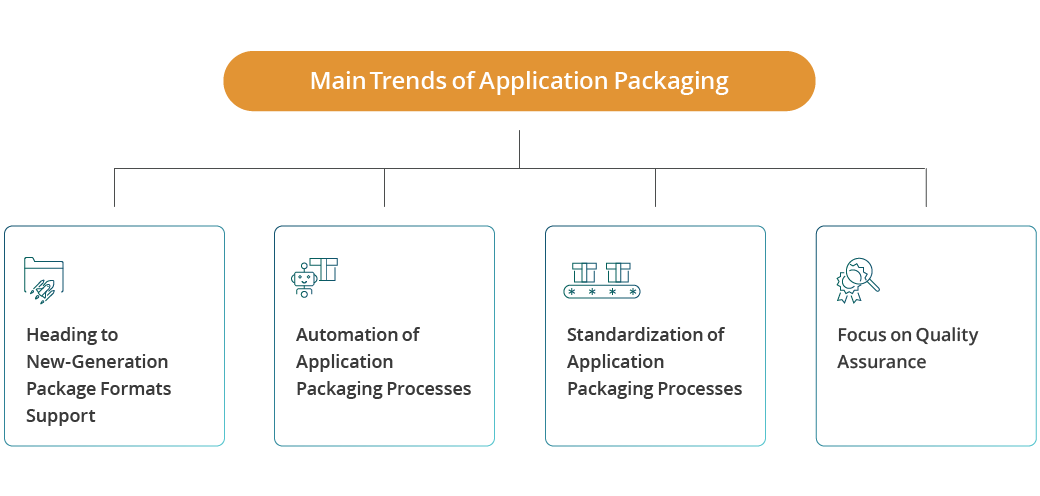Application packaging has been on the market for over 20 years and evolved with technological advancements. Businesses strive to keep their infrastructures as stable as possible, providing security, lowering financial costs, and ensuring continuous operations. As a result, the applications packaging market has become more complex and demanding, requiring constant improvement and technological advancements.
This article will go through significant application packaging trends expected to hit the market shortly.
Application packaging: Heading to New-Generation Package Formats Support
Currently, the app packaging world is balanced between two entities: those sticking to old-school technologies (MSI, App-V, ConfigMgr) and those who have already shifted to modern ones (MSIX, Intune). With Windows 10 came many changes that could slow your application packaging and testing progress.
MSIX is now the most modern application package format with a streaming-based implementation, ensuring higher safety of deployment and removal, disk space optimization, and much more. In addition, MSIX packages have high-security levels.
Despite many advantages, MSIX cannot replace the MSI package at the moment, as it has some limitations that prevent a significant part of applications from working inside an MSIX container.
It is unknown how long Microsoft will allow installation of MSI packages, yet their decision may enforce extensive usage of MSIX in the future.
To ensure a smooth and straightforward application packaging process, businesses seek solutions that can support both old and new package formats.
Packaging experts tend to implement an end-to-end packaging solution that works with multiple package formats (MSI, MSIX, APPX, App-V, Thinapp) and repackages existing installations into MSI to enhance the packaging process’ quality, safety, and velocity.
Automation and Standardization of Applications Packaging Processes
Modernization and automation of IT processes (including application packaging testing and creation) have become somewhat of a rule than a trend.
To stay in tune with it, organizations are looking for IT automation to manage their application processes and their entire packaging workflow.
You need the ability to create robust and complete installation packages to be installed in the unattended mode.
Automation of application packaging operations
IT companies today require a holistic packaging solution to automate major packaging processes. The tools they use must ensure that packages are safer, cleaner, and ready for deployment than ever before, without spending too much time on reviews and fixing mistakes.
Automation of application packaging workflow
Standardization & partial automation of your workflow is the primary straight-to-the-point demand to provide a steady, reliable, and smooth lifecycle.
Companies aim at getting a centralized workplace for multiple isolated projects with repository management for package delivery, covering the entire application packaging life cycle starting from receiving orders directly from your clients in the solution, maintaining communication with customers, and task and team workload management.
Focus on Quality Assurance
The installation process must result in properly configured software that will run error-free. That means the installation parameters have to be set and pre-configured. All necessary setting rules should be specified and checked before a package is made, including those settings modified at or after the initial launch of an application. Quality Assurance (QA) is an inevitable part of the application packaging process. Testing is a complex and cumbersome process much faster with automation tools.
Before deployment in the enterprise, MSI packages must be tested and checked for package consistency. In addition, MSIX packages must be checked for readiness for deployment and compliance with the Microsoft Store and Windows Desktop Bridge requirements.
The perfect solution must enable testing for safety and compatibility.
PACE Suite provides testing support with Quality Approver – an in-built tool that automates package quality control, all the way down to preparing a test report for your packages. In addition, it works with the most popular package formats: MSI, MSIX, and APPX.

Conclusion
Following market trends ensures higher productivity, cost savings, and competitiveness today. Therefore, a tool-driven approach is an inevitable part of any application packaging process to make your application packaging processes faster, preserving quality and technological velocity.
Companies need to reduce the effort while advancing with this transition or staying in “the middle” for a while because changes inevitably bring a lot of uncertainty.
An application packaging solution is a winning option for enterprises and IT service providers, enabling them to save costs and time and determine the right strategy.
Bring the change to your application packaging operations with PACE Suite, organize your work processes, ensure better customer-packager interactions, improve Task management flow, and integrate repositories with PACE Packager Hub.
These two products work seamlessly together, enabling better performance and driving dramatic positive changes to your business, allowing you to stay on top of the global application packaging trends.
Source: https://pacesuite.com/blog/future-of-applications-packaging-main-trends/











Recent Comments